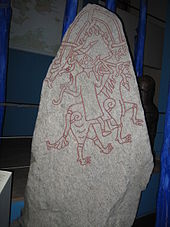Hunnestad Monument
The Hunnestad Monument ( Swedish Hunnestadsmonumentet ; in the Rundata catalog no. DR 282-286) stood at Hunnestad in Marsvinsholm, northwest of Ystad in Sweden . It was the largest and best-known monument from the Viking Age (800-1050 AD) in Skåne and its importance was only comparable to the Jelling stones in Denmark .

The eight-stone memorial was probably destroyed between 1782 and 1786 by Eric Ruuth , owner of Marsvinsholm Castle . However, it survives long enough to be documented for posterity. When the Danish archivist Ole Worm researched and drew the monument in 1620, it consisted of eight stones. Magnus Dublar (1665–1735) found it intact in 1716.
description
Five of the stones were picture stones. Two picture stones, which should also be the youngest, also had runic inscriptions . One carried a cross, which means that the group, whose earliest monument cannot be dated, can be dated to the end of the Viking Age. The remaining three were rune stones , which Ole Worm did not consider. Three of the stones can be seen in the Open Air Museum Cultures in Lund .
The only surviving picture stone, also in the open-air museum cultures, the stone DR 284, is said to represent the giantess Hyrokkin, who is mentioned in the Snorra-Edda in the context of Balder's death. She rides the big beast and uses snakes as reins.
literature
- Sigmund Oehrl: On the interpretation of anthropomorphic and theriomorphic image representations on the late Viking Age rune stones of Sweden (= Vienna Studies on Scandinavian Studies. Vol. 16). Praesens, Vienna 2006, ISBN 3-7069-0346-6 .
Web links
Coordinates: 55 ° 28 ′ 20 " N , 13 ° 43 ′ 32" E
